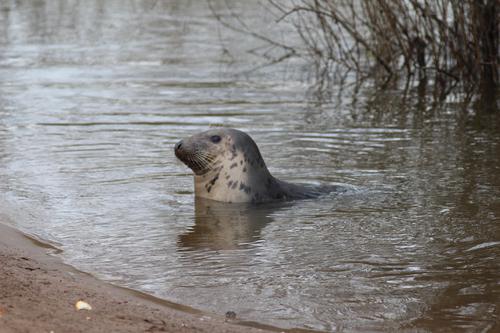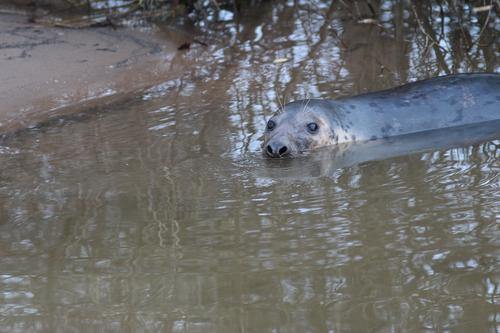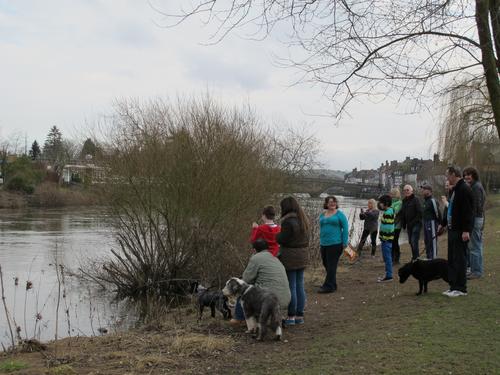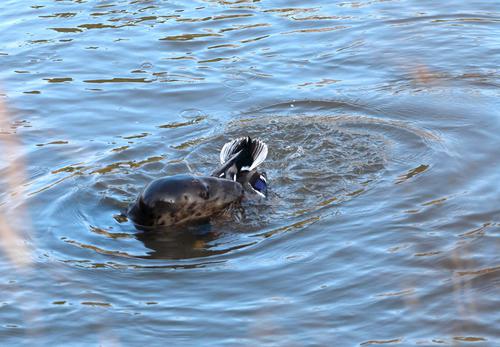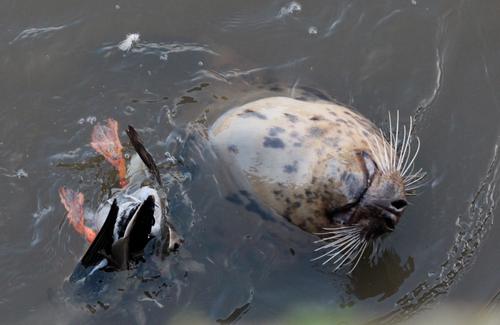Grey Seal Halichoerus grypus in Worcestershire
Rosemary Winnall
Just after the Worcestershire Mammal Atlas (Green et al 2012) had been published with no mention of the species, a Grey Seal Halichoerus grypus appeared in the county along the River Severn! It provided headline news in local papers and caused much discussion amongst naturalists and anglers. Her inquisitive nature endeared her to many onlookers and she became quite a celebrity. People were seen in all weathers staring out across the water with a wistful look in their eyes; complete strangers were seen talking to each other in animated fashion; and this single animal brought people and nature together in a unique way. Keith the Seal even had an internet Facebook page of her own and people were following her on Twitter!
The seal was first spotted on 17 November 2012 by a group of Wychavon Kayak and Canoe Club canoeists paddling down the River Severn near Powick, just south of Worcester. They watched it for half an hour as it swam between their boats, and they were able to take photographs of this surprise addition to their flotilla! It was these kayakers who named the seal Keith after the Scottish aristocrat Royalist Commander Colonel George Keith who fought for Charles 1 against the Roundheads in the English Civil War, and whose troops were eventually defeated as they tried to defend Powick Bridge in the Battle of Worcester in 1651.
The Grey Seal was soon confirmed as a female, but the name Keith stuck for the duration of her stay. Grey Seal females do not mature until they are four or five years old, and young animals are known to disperse widely from the rookery where they were born; the nearest known breeding colonies are on Lundy Island and Skomer Island. Females (cows) are smaller than the males (bulls), and can grow up to 2.0m in length and weigh up to 420lb.
Over the next few weeks Keith was seen and photographed at a number of places along the River Severn and I attempted to record her movements from newspaper and internet reports, as well as from personal observations, checking head markings in photographs to confirm identity. The most northerly record I had for Keith was just upstream of Bewdley near the stanchions of the old railway bridge that used to cross the river by the Dowles confluence. Table 1 documents these confirmed sightings.
| Date | Place | Activity |
| November 17 2012 | near Powick, followed canoeists | eating salmon |
| November 18 2012 | Diglis Weir, Worcester | eating large chub and 2 pike - 3 in 30 mins! |
| November 22 2012 | Ketch Caravan Park, Worcester | playing with plastic bottle |
| November 30 2012 | Upton-upon-Severn | |
| January 1 2013 | Bewdley, Severnside North | eating fish |
| January 2 2013 | Stourport Marina | present all day, eating salmon and pike |
| January 4 2013 | Bewdley | in river close to the town |
| January 5 2013 | Bewdley and north near Dowles | playing around canoeists |
| January 6 2013 | Bewdley in the town and up near Dowles | caught fish then came to rest up in shallows for 2 hours |
| January 12 2013 | Bewdley | |
| January 13 2013 | near Dowles outflow and in Bewdley all day | with rowers, close to many people, eating mallards |
| January 17 2013 | Bewdley | eating fish |
| January 19 2013 | evening - Lenchford Hotel, near Holt Fleet | out on the bank in the snow |
| March 9 2013 | below Gloucester | with paddle boarders, tried to climb on board! |
Table 1. Sightings of Keith
Keith spent over two weeks in Bewdley in January 2013 where I was able to watch her on three occasions: the 4th, 6th and 13th. The last two days were both Sundays during which I watched her for about two hours on each occasion. She seemed to enjoy playing amongst the rowing boats that always practice on Sunday mornings, and she stayed around in the centre of Bewdley even though (or because?) there were so many people walking the banks. It was an amazing sight to witness a Grey Seal so far from the sea and so close to people, dogs, boats and traffic!
We Bewdley inhabitants were rather touched that this wild animal had adopted our stretch of the river for so long during January and we felt privileged that it often seemed to choose to be close to people. However, the reason for this was probably not to do with the charisma of the local residents, but linked to the local geology and history of the river!
To swim from the sea in the Bristol Channel as far as Bewdley Keith must have had to cross six weirs. Before these were constructed seals and porpoises were occasionally recorded in Worcestershire’s rivers and even Sturgeons were recorded as far upstream as Worcester.
An Act of Parliament was passed in 1842 to allow the River Severn to become navigable between Gloucester and Stourport. During the next 30 years, not only were six locks and weirs constructed, but the river was dredged and deepened by the removal of rock bars, so that a consistent depth of 10 feet was obtained for the passage of boats. The following table shows details of these weirs.
| Weir | Near | Built | From Bewdley |
| Maisemore Weir | Gloucester | 1871 | 45 miles |
| Upper Lode Weir | Tewkesbury | 1858 | 34 miles |
| Diglis Weir | Worcester | 1844 | 18 miles |
| Bevere Weir | Grimley | 1844 | 13 miles |
| Holt Weir | Holt | 1844 | 10 miles |
| Lincombe Weir | Stourport | 1844 | 5 miles |
Table 2. Weirs on the River Severn between Bewdley and the sea
So how did Keith manage to find her way upstream of these weirs? The lowest weir at Maisemore near Gloucester, is overtopped by each high tide so seals have been recorded in the river as high as the Tewksbury weir fairly frequently, but seal records above this are very unusual. The next weir near Tewksbury, the Upper Lode, is covered at exceptional high tides, but all the other weirs upstream are only covered when the River Severn is in flood. There were flood conditions on the Severn at various times during the late autumn and winter of 2012/13 providing Keith with opportunities to cross the weirs with no trouble as she followed the salmon coming upriver to spawn.
I first watched this seal when the flood barriers were up in Bewdley town. The water was running very fast and it was brown with sediment. But Keith seemed perfectly at home swimming against the current, resting in the eddies and catching fish regardless of the poor visibility. Although seals have good eyesight, underwater they rely predominantly on hearing and touch to detect their prey, having highly sensitive whiskers. They can stay submerged for up to 20 minutes due to high haemoglobin content in their blood which allows the absorption of high levels of oxygen.
I went to talk to one of the fishermen to see what he thought about the presence of this mammalian predator in the river. He stressed that although he loved the wildlife of the river, this seal was certainly affecting the fish population. Apparently the fishing is particularly good around Bewdley because the river has not been canalised. The geology and river erosion provide a good mixture of deep pools, cracks and crevices in the bedrock in which the fish can hide and rest. He explained, that although there were originally no native Barbel in the Severn, they were introduced in 1955 and now the Severn is one of the best rivers for these fish in the country. They are very long lived and some of the individual Barbel near Bewdley are between seven and 12 years old. During the winter they go into a state of quiescence, becoming very sluggish, and they hide in the rocky crevices on the river bed. They only gain mobility again when the water reaches 7°C and above. Barbel were being eaten regularly by Keith along with Salmon, Chub, and Pike, and they were easy prey in this state. Also the fish were not used to predators of this sort and so had not developed escape tactics.
I was surprised at just how large the fish were that Keith caught, but she was regularly observed eating just part of the fish, particularly the blood-rich parts such as the intestines and the gill rakes, then going off to catch another one, thus killing many more than was needed to sustain her! Perhaps Keith became bored of fish, because on Sunday 13th January, she was seen catching and eating ducks! Now these were not any old ducks, they were our Bewdley ducks, and one could sense some dismay amongst the town residents as Keith floated past dismembering a Mallard drake close to Severnside North, his second of the afternoon! Interesting discussions ensued, especially amongst those who knew nothing about fish and had no concerns about Keith eating them; but Bewdley ducks that we could see, throw bread to, and tame, were different - or were they? All interesting!
The local anglers became very concerned about the depletion of fish stocks around Bewdley and the Angling Trust applied to Natural England for a licence to shoot it. There was outcry from the seal enthusiasts and an online petition was launched to try to save her. The Environment Agency became involved and stated: “We are aware of the seal at Bewdley and understand the concerns of the salmon and coarse fisheries and anglers. However, one animal on a large river like the Severn in unlikely to have a significant impact on fish stocks. This is ‘natural predation’ and it will eventually make its own way back out to sea. With this in mind, and also because seals are a protected species, we won’t be taking any action.” Eventually an agreement was reached between the Angling Trust and the British Divers Marine Life Rescue to monitor the seal’s movements and to rescue it if it stayed in one place for too long. They also recommended a scrammer which emitted a loud noise to act as a seal scarer. I can find no record of any action that was taken by these organizations.
Soon afterwards sightings of Keith stopped and we all hoped that she was making her own way back downstream, and intervention would be unnecessary. One late record and internet movie of her near Gloucester playing with some paddle boarders on 9th March was the last confirmed sighting.
Recent records of seals in the Severn include an injured Grey Seal found on the bank of the river near Lower Lode, just inside Gloucestershire. This was taken to the Vale Wildlife Rescue Centre in December 2010. It was dehydrated and underweight and had bite marks on its back end, but it was nursed back to health and released down at the coast some weeks later. There was apparently one seen near Holt Fleet in the 1980/90s, although no confirmation of that record can be found.
The UK has about 36% of the world’s population of Grey Seals and numbers have increased since culling was stopped in the 1970s. So we might see Halichoerus grypus (meaning hook-nosed sea-pig) more regularly in the county when the Severn is in flood and as female Grey Seals live for about 20 years, Keith may yet return!
References:
IUCN – The World Conservation Union. Seals. 1995
MacDonald, D. and Barrett, P., 1993. Mammals of Britain and Europe. London, HarperCollins
Tomes, R.F. 1901 Mammals in Willis-Bund, J.W. and Doubleday, H.A. (Eds.) 1901. The Victoria History of the Counties of England, Worcestershire, Volume 1. London, Dawsons.
http://www.facebook.com/keiththeworcestershireseal
http://www.facebook.com/savetheseal
Canoeists Guide to the River Severn http://cdn.environment-agency.gov.uk/gemi0504bvfu-e-e.pdf
Image
Fig. 1. Keith the seal at Bewdley 6th January 2013. Rosemary Winnall.
Fig. 2. Keith the seal at Bewdley 6th January 2013. Rosemary Winnall.
Fig. 3. Keith the seal close to the bank and admirers, Bewdley 6th January 2013. Rosemary Winnall.
Fig. 4. Keith the seal with Mallard drake, Bewdley 13th January 2013. Rosemary Winnall.
Fig. 5. Keith the seal with Mallard drake, Bewdley 13th January 2013. Rosemary Winnall.
